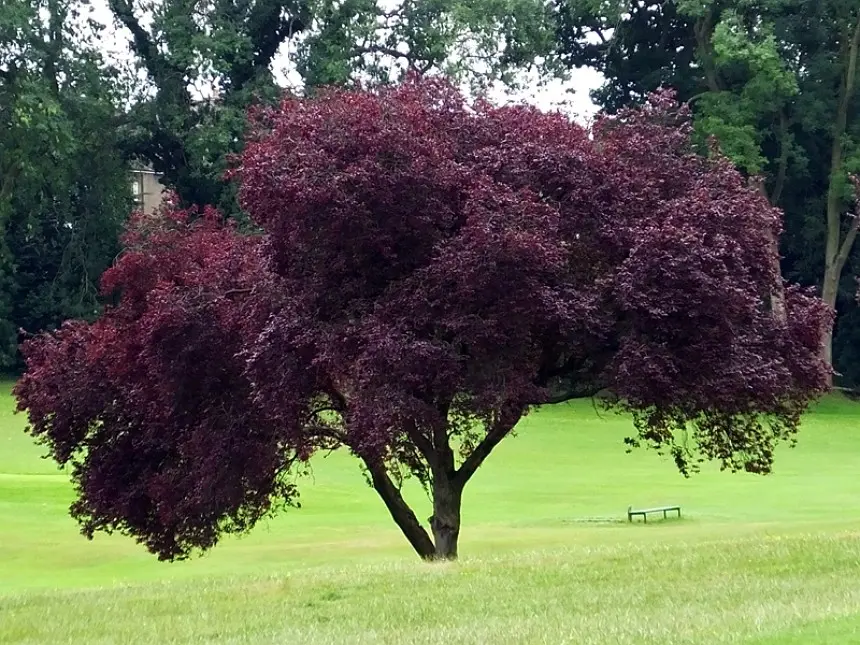Contents
Decorative plum is a tree with unusual red foliage, interesting not only for its delicious fruits, but also for its attractive appearance. It is worth studying the description of the red-leaved plum with a photo and evaluating its merits.
Meet the decorative plum tree with red leaves
When choosing the first trees for their garden, most gardeners do not think about their appearance – the main role is played by delicious fruits. However, over time, there is a need for beauty – and then the decorative red-leaved plum comes to the rescue.
The leaves of the ornamental plum are not green, like most trees, but a rich red-violet color. Therefore, in the garden, the plant plays the role of a bright accent. If a decorative plum with red leaves is chosen tall and spreading, then it stands out from other trees, and if squat and short, it can border them or serve as a hedge.
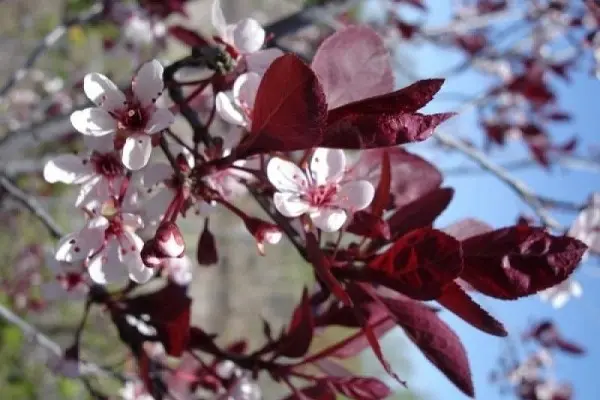
What are the varieties of red-leaved plum
Plum with burgundy leaves is divided into many varieties, but they are usually combined into four large varieties:
- .
- splayed.
- Decorative purple leaf.
- Plum Hollywood.
Line of hybrids ” plum”
Particularly popular in the middle lane are varieties of ornamental plum, obtained by crossing southern cherry plum with Ussuri or Chinese plum.
Scarlet Sails
The red-leaved plum of this variety is a tree up to 4 – 5 m in height, with a thinned, but spreading crown, with large leaves of saturated red color. Plum with red leaves and dark pink flowers bears fruit in mid-August. Scarlet sails have a dark crimson color and an average weight – each fruit weighs about 25 g.
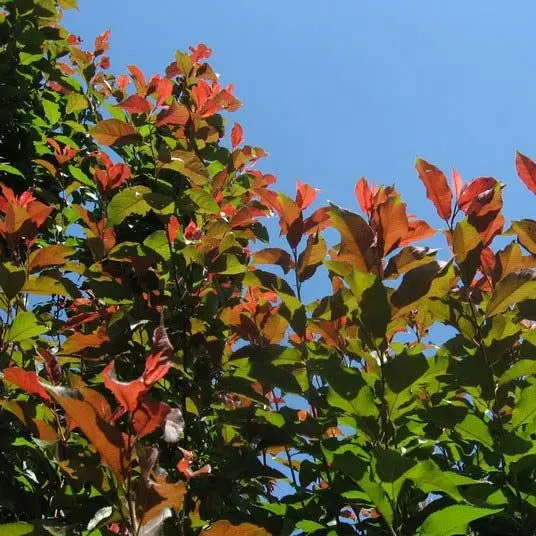
Among the advantages of Scarlet Sails are high resistance to negative temperatures and drought, low susceptibility to fungal diseases. The tree gives abundant harvests and bears fruit every year, but it belongs to the category of self-fertile. For Scarlet Sails, Chinese plum varieties Skoroplodnaya and Krasny shar, as well as cherry plum Melon can become pollinators.
Lama
This ornamental variety of plum is small in size – 1,3 – 2 m. The crown is round-flat, dense, the leaves are dark red throughout the summer period. Plum with pink flowers produces large crimson fruits, each of which can weigh up to 40 g.
The red-leaved Lama variety was bred specifically for growing in the middle lane, therefore it calmly tolerates frosts down to -35 degrees. The shoots of the tree are not afraid of light spring frosts, the variety has an increased resistance to pests and diseases.
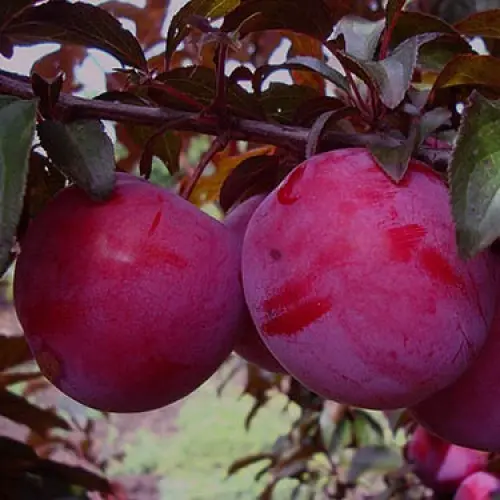
The llama is a self-fertile ornamental plum, so pollinators are required for annual high yields. Chinese plums and cherry plums with flowering in mid-May are well suited for this variety – for example, Vitba, Mara and Asaloda.
Early
plum Early – a large tree up to 7 m in height with a rounded crown, large red leaves with serrated edges and a brown underside of the leaf. It has equally good resistance to frost, diseases and pests, brings abundant harvests from fruits of dark red color.
The tree, like most plum cultivars, is self-sterile and therefore requires pollinators, which are ideal for cherry plums and early-blooming Chinese plums.
Nigra
Another red-leaved ornamental variety is Nigra, a low tree with an oval crown. Young leaves are ruby in color, adults are dark purple. The red-leaved plum blooms with pink flowers in late April or early May, even before foliage appears on the branches. In late August, it bears dark red round fruits.
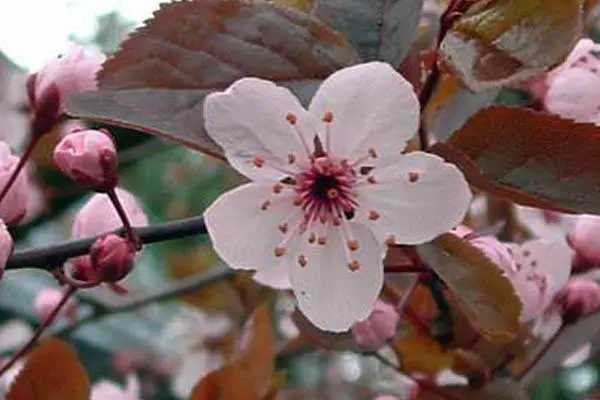
It tolerates frosts below -30 degrees and summer drought, does not break under the wind, rarely suffers from diseases typical of fruit trees. A pollinator for a variety can be Eurasia plum or homemade Hungarian.
Spreading plum
The splayed plum belongs to the category of red-leaved trees of high and medium growth with abundant and fast fruiting – the first crops are harvested from it as early as 2 years after planting. As a rule, varieties of splayed plum are intended for cultivation in warm climates.
Hesse
A shrubby cultivar of the red-leaved plum called Hesei produces regular green foliage at first – but then the leaves turn purple, with a pink or cream border around the edges. The variety blooms with white flowers at the end of April, before the foliage blooms or simultaneously with it. It bears sweet and sour small red fruits.
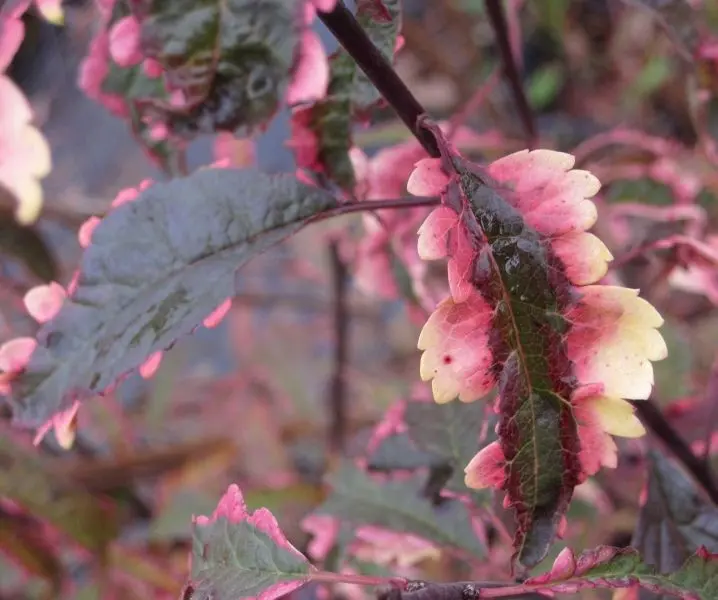
The variety is characterized by low frost resistance and tolerates negative temperatures only up to -28 degrees. Of the diseases, black or perforated spotting remains dangerous for him. To obtain fruits, it is necessary to plant splayed plums nearby with similar flowering periods.
Pissardi
Iranian plum variety up to 6 m tall with dark purple leaves and red shoots. Pissardi is an ornamental plum with pink flowers that blooms in early spring before the foliage blooms. In August, it produces abundant fruits of pink color – provided that other varieties of spread red-leaved plum with flowering in late April were planted nearby for pollination.
The frost resistance of the Pissardi variety is not very high – from -20 to -28 degrees. But the tree is highly resistant to disease.
Cisterna
This ornamental variety was obtained by breeding sand cherries and red-leaved Pissardi plums. The dwarf plant grows only up to 2 m, and at the same time it grows very slowly, so the Cysten plum is more often referred to as shrubs with a columnar crown. The leaves are elongated-round and serrated, dark purple on the underside and red-violet on top.
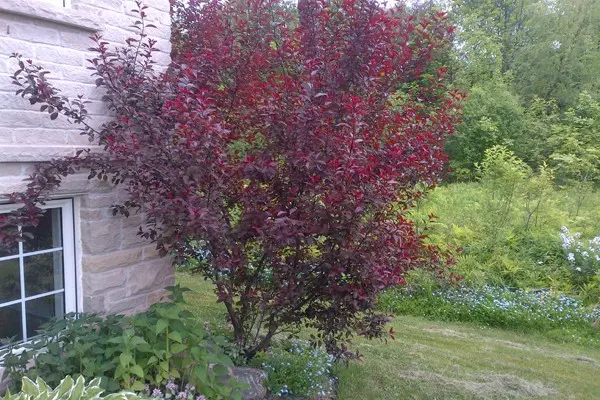
The red-leaved Cystena blooms in early spring with white flowers with a red core, and at the end of summer it bears fruits – dark purple small drupes. If you plant other varieties of low red-leaved plums nearby, Cystena will delight you with abundant harvests.
The frost resistance of the variety is low, so it is not recommended to breed Cystena in cold regions. But the variety is quite resistant to diseases and pests.
Plum decorative purple-leaved: photo + description
To decorate the garden, a decorative purple-leaved plum is ideal – a shrub reaching 1,5 in height, with elongated lanceolate leaves. At the very beginning, the foliage of the plum shrub has a dark red color, then, as it grows older, it can turn to a dark brown hue. The ornamental purple-leaved plum produces white or light pink flowers at the same time as the foliage appears, and in late September brings a crop of dark red fruits.
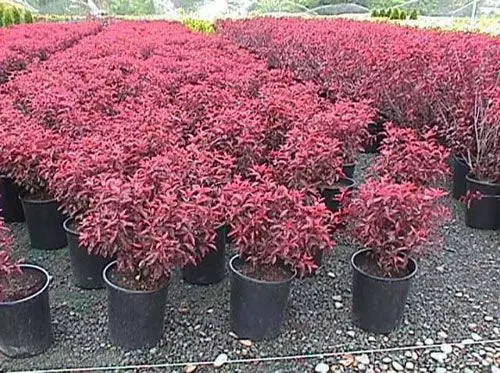
It is best to plant plums in windless sunny places, in well-drained, slightly alkaline or acidified soil. The winter hardiness of the shrub is high.
Red-leaved plum “Hollywood”
One of the most popular red-leaved varieties is Hollywood. The plum tree reaches several meters in height, has a spreading sparse crown, which is formed by dark red shoots and red leaves. Hollywood blooms with white flowers. Attractive is not only the appearance of the plant, which can be appreciated from the photo of a plum with red leaves. The variety also bears purple-red tasty fruits in mid-August.
During the harvest period, Hollywood enters 5 years after planting, gives juicy and sweet fruits. The best pollinators for the self-fertile variety will be the collective farm Renklod and Mirnaya plum.
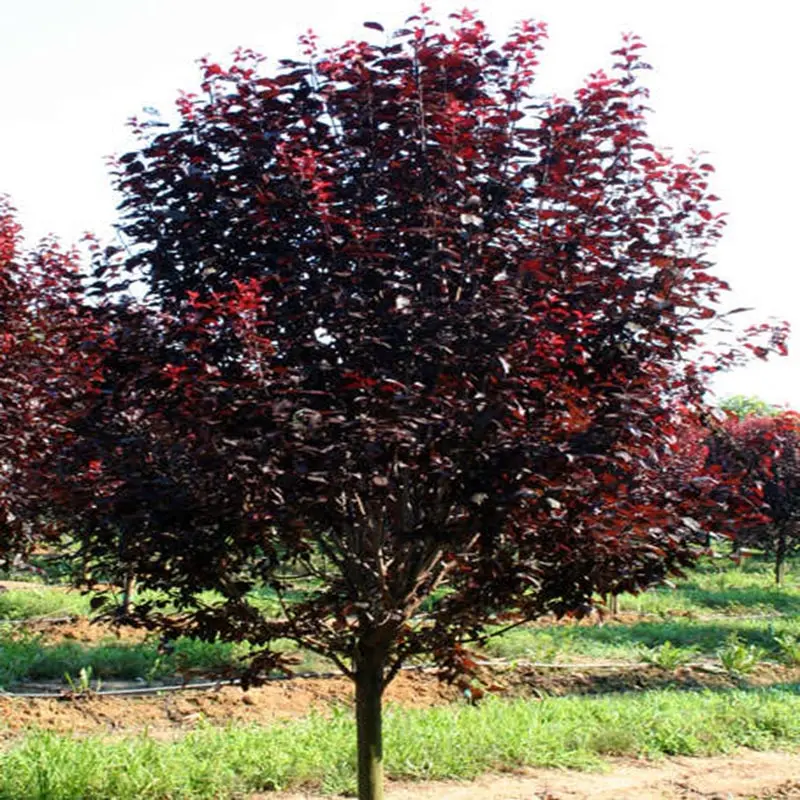
The nuances of growing decorative plums
Plum varieties with burgundy leaves can be quite different from each other – it is quite difficult to form uniform care rules for them. But the general nuances still exist.
- Decorative plums do not like excessively waterlogged soil; it is better to plant them in soil with a neutral level of acidity.
- Before planting in a pit for a seedling, it is necessary to apply organic fertilizers – humus and superphosphate, which will nourish the plant in the first 3 years of life.
- After entering the harvest time, red-leaved plums are regularly fed with mineral fertilizers and organic matter. In the spring it is necessary to apply nitrogen fertilizers, in the summer – a solution of mullein and potassium. In autumn, the ground around trees and shrubs is dug up and also flavored with humus.
- Water decorative plums as needed – do not allow the soil to dry out. Usually every 1 – 2 months, with moderate rainfall, 4 – 5 buckets of water are brought under the roots.
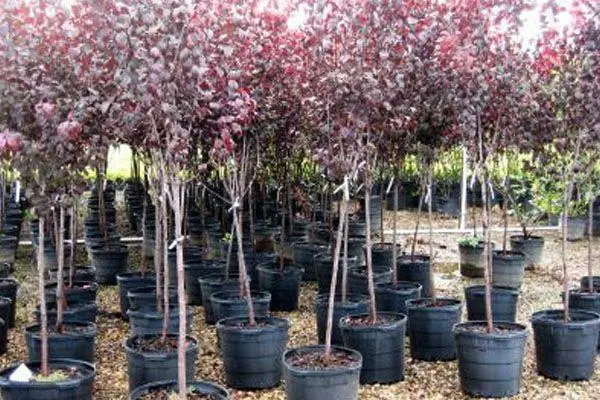
Decorative plum with red leaves without fail needs pruning, which is carried out annually. Red-leaved trees, and especially shrubs, tolerate cutting well, crowns are rounded, sparse or vase-shaped.
Conclusion
Decorative plum with red leaves is a great decoration for any garden. It is mainly used as a landscape element, but in the presence of pollinators, red-leaved varieties will bring stable yields.
